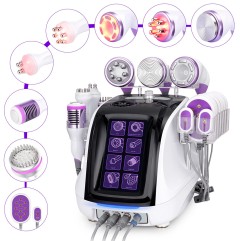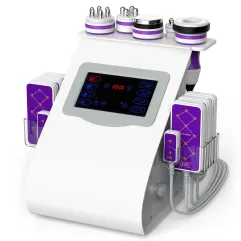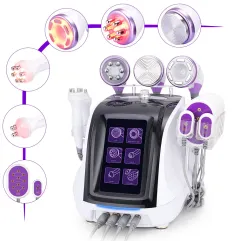 Ultrasonic fat reduction machines have gained massive popularity in the weight loss and beauty industry as noninvasive treatment providers. However, one crucial thing that confuses buyers is the wide range of prices offered for these cavitation devices. From technology and innovation to brand reputation and features, several factors contribute to the price disparities of these fat-reduction devices. In this guide, we will discuss each factor in detail and deeply analyze their impact on price disparities to help you make an informed purchasing decision.
Ultrasonic fat reduction machines have gained massive popularity in the weight loss and beauty industry as noninvasive treatment providers. However, one crucial thing that confuses buyers is the wide range of prices offered for these cavitation devices. From technology and innovation to brand reputation and features, several factors contribute to the price disparities of these fat-reduction devices. In this guide, we will discuss each factor in detail and deeply analyze their impact on price disparities to help you make an informed purchasing decision.
Factors Impacting Price Disparities in Ultrasonic Fat Reduction Devices
Here are the significant factors that influence the pricing strategies of these devices.
1. Technological Research and Innovation:
Ultrasonic cavitation devices use advanced technology and innovative features to deliver effective and safe weight loss results. The level of technological research and innovation used in these machines significantly impacts their prices. The manufacturers of ultrasonic cavitation devices invest in technical research and development to enhance the effectiveness of these devices, so the costs associated with incorporating technology are reflected in the prices of these devices.
Ultrasonic Transducers
Ultrasonic transducers are critical components in ultrasonic cavitation machines. The quality and performance of ultrasonic transducers in cavitation machines play an essential role in machine performance and treatment effectiveness. Manufacturing advanced ultrasonic transducers involve significant research, development, and testing procedures.
High-end ultrasonic devices feature advanced transducers that offer higher frequencies enabling precise targeting of fat deposits and better penetration. They incorporate high-end focusing technology to concentrate the waves on specific areas.
Also, these transducers have a cooling mechanism to prevent overheating during the procedure. So, the costs associated with all these processes to develop high-quality transducers and integrate them into devices can increase the price.
Energy Delivery Systems
The energy delivery system in an ultrasonic cavitation device determines the effectiveness of treatment. The system is responsible for delivering ultrasound energy to the treatment area. Also, it determines the frequency, intensity, and duration of ultrasonic waves. Cavitation devices with innovative energy delivery systems use advanced techniques to supply even and controlled energy output which leads to more suitable fat cell disruption.
High-priced ultrasonic fat reduction devices offer a range of energy delivery options, such as adjustable energy levels and treatment presets. Thus, developing and integrating these power delivery modes can contribute to device price disparity.

Real-Time Monitoring
Some high-end and sophisticated devices offer real-time monitoring features that allow operators to monitor treatment progress, adjust the settings accordingly, and ensure patient safety. Real-time monitoring includes features like temperature sensing and feedback mechanism to control and optimize the treatment by providing accurate information to practitioners. Ultrasonic cavitation devices with real-time monitoring features ensure treatment safety by minimizing unnecessary risks.
As real-time monitoring enhances treatment precision, it requires extra sensors and integration of software and user interfaces to develop these capabilities. So, the devices that offer real-time monitoring have higher prices in the market.
2. Brand Influence and Reputation
In the competitive market of ultrasonic cavitation devices, brand influence, and reputation play a vital role in shaping the pricing strategies of these devices. Buyers associate brands with trust, quality, reliability, and customer satisfaction.
When consumers hear about the positive experiences of others with a particular brand, they're more likely to buy the device from that brand with a good influence and reputation, even if it comes at a higher price. This perception impacts the value of products which leads to variations in pricing. Leading brands with a strong reputation often command higher prices due to the following factors:
Research and Development Investment
Established brands invest time and significant resources in research and development to improve their products, which sets them apart from competitors. Such brands are perceived as more credible among customers. The costs associated with research, trials of machines, and regulatory adherence are usually reflected in the pricing of their devices.
Customer Support and Warranty
Reputable and well-known brands offer comprehensive customer support and generous warranty terms for their equipment. These services show they have confidence in the performance and quality of their devices. These additional services usually come at a cost highlighted in their pricing.
However, buyers are ready to pay a premium price for assurance of customer support and superior performance as they feel secure knowing that the brand stands behind their products and they're protected against any defects.
3. Features and Configurations
The range of device features and configurations offered by manufacturers is a significant factor that contributes to price disparities in ultrasonic weight loss devices. The addition of features and customization options in these devices affects their prices. Higher-priced machines offer a vast range of features and extensive configurations. Let's explore how different features and configurations impact the overall cost of these devices.
A. Adjustable Energy Levels and Treatment Modes
Ultrasonic Cavitation machines often offer adjustable energy levels that allow practitioners to customize treatment according to each patient's needs and treatment area. Including adjustable energy levels adds value to the device but contributes to higher pricing. In addition, ultrasonic fat reduction devices offer multiple treatment modes, including continuous wave, pulse mode, or combination mode treatment. So, these weight loss devices have different configurations tailored to multiple treatment modes and energy delivery options.
B. User-friendly Interfaces and Additional Functionalities
Devices with user-friendly interfaces and advanced controls simplify the treatment procedure for both the operator and the patient. Easy navigation, clear LED displays, and ergonomic design lead to a better user experience. Moreover, advanced ultrasonic devices also offer additional features such as skin tightening, body contouring, or other aesthetic treatments.
C. Treatment Area-Specific Applicators
Ultrasonic devices often have a range of applicators that are specifically designed to target different treatment areas. These applicators or handpieces vary in shape, size, and functionality to offer different body contour treatments. Some manufacturers offer multiple customization options for applicators that enable treatment providers to tailor the treatment according to individual patient needs.
D. Advanced Safety Features
The first and foremost thing to consider while designing ultrasonic fat-reduction devices is the patient's safety. Therefore, advanced safety features, including temperature sensors, auto shut-off mechanisms, and real-time monitoring, are incorporated in expensive and sophisticated ultrasonic cavitation machines. However, these safety features require additional sensors and technological considerations, due to which the manufacturing cost of the device and its overall price have increased.
4. Materials and Manufacturing Processes
Materials used in building ultrasonic cavitation devices determine the quality, durability, and overall performance. Low-quality materials create a less robust machine that will require regular repairs or replacements. When analyzing the impact of materials and manufacturing processes on price disparities of devices, it is necessary to balance cost and quality. Buyers should assess the quality of the materials used in the device to make sure the device provides optimal performance and meets industry standards. Also, consider long-term costs while buying, such as repairs and maintenance, to determine the actual value of the device.
5. After-Sales Service and Warranty
Manufacturers include the cost of these services in the initial price of the device because they will have to cover expenses related to training programs, warranty claims, and continuous customer support. Here are the primary elements included in after-sales service and warranty:
Training Programs
Ultrasonic weight loss devices require proper knowledge and training of the device to operate it effectively and safely. Therefore, some manufacturers provide training programs to buyers or operators that train them to understand device functions, settings, and safety guidelines to help them properly use the device and achieve desired treatment results. Training programs can be online, like courses, or in-house. However, these programs require training resources and expertise, which contributes to device costs.
Extended Warranty
Established manufacturers offer great warranty options that are beyond the regular coverage. This feature provides extra protection to the device for an extended duration. However, if any damage occurs to the device in this timeframe, the manufacturer will cover all the repair or replacement costs. Reliable customer support, including technical support, troubleshooting advice, and guidance, is another service that adds value to the device. Prompt access to responsive customer support ensures buyers that their concerns or queries will be addressed quickly.
While incorporating comprehensive warranty services adds value to the device, it also increases its price. Most importantly, these services offer peace of mind to buyers by providing protection against unexpected expenses.
6. Regional and Sales Channel Factors
The regional and sales channel factors play a crucial role in determining pricing strategies embraced by manufacturers and distributors that affect the price disparities of devices across different markets.
Regional Factors
Market demand and competition in different regions impact the pricing of these devices. Manufacturers adjust their prices in regions with higher demand and greater competition to attract sales and gain market share. The production and distribution costs vary across the regions depending on various factors such as labor costs, transportation expenses, material availability, and import taxes.
Sales Channel Factors
When manufacturers sell directly to buyers through their online platforms or company-owned physical stores, they eliminate markups associated with retailers. Therefore, prices are lower for devices that are purchased directly from manufacturers. On the other hand, when devices are marketed through retail distributors, this channel includes costs associated with distribution and retail margins, which may contribute to higher prices.
Conclusion
Several important factors impact the rice disparities in ultrasonic fat reduction devices. The level of technological research and innovation, brand reputation, features, materials used, warranty, and after-sales service all contribute to variations in pricing. Therefore, you must understand all these factors to make an informed buying decision and choose a device that best suits your budget and needs.





